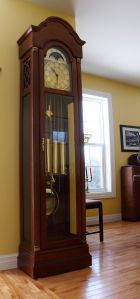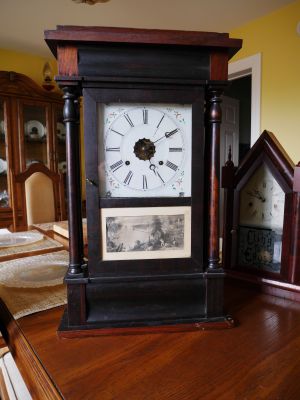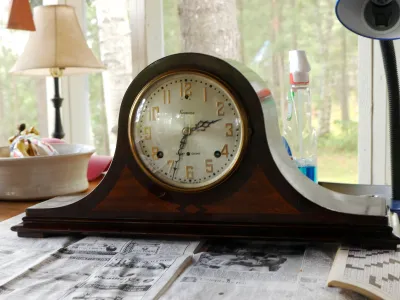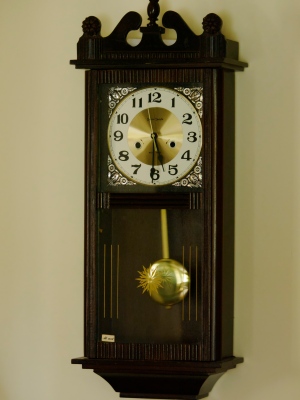Every clock owner wants to know what their clock is worth and every clock seller wants to know what price they can ask for. This article will provide a guide to buying or selling an antique or vintage clock.
I will attempt to answer the following questions beginning with comments about the unpredictable clock market.
- What factors are considered when assessing the value of a clock?
- Is it original?
- What type or style of clock is it?
- Does the clock have a label, trademark, or prominent name?
- Is it from the correct period or is it a “knock-off” or “re-issue”?
- Does the clock have provenance?
- What is the age and condition?
- Is the clock collectible?
- What is the mechanism type?
- It all comes down to research
The unpredictable clock market
Unfortunately, in this unpredictable market, it is almost impossible to determine the value of a clock. What you think your clock may be worth today may not align with what the experts say and what others are willing to pay. What has value today may not have value tomorrow. Many factors influence the buying and selling of clocks and the clock market can be a battlefield with many casualties.
Recently, I saw a mid-1990s Howard Miller grandfather clock listed for sale on a Facebook site. I tracked the ad over the course of several days. The owner originally wanted $3000 but later stated they would take “no less than $1500” when it became obvious to them that the ad was not attracting attention. Personal value tends to be subjective and while the owner might have paid $3000 or more for a beautifully carved oak grandfather clock, its present value is not anywhere near what he thinks it is worth. I stopped following the ad but the seller likely withdrew it from sale.
Even an appraised value is the subjective opinion of an expert assessment based on condition and collectibility which is always subject to shifts in the market. My Ridgeway grandfather clock is in excellent condition, runs well, and has a command presence in my home but it is not worth much in today’s market.

What factors are considered when assessing the value of a clock?
Is it original? Original clocks attract buyers. The value of a clock decreases if some or many parts have been changed out. Determining whether or not a clock is original can often be difficult to determine unless viewed by an expert. The many “Vienna Regulator” clocks found on eBay and other online for-sale sites are missing parts, have had parts added such as crowns, finials, dial faces, hands, and even movements, and have weights that are not original to the clock. Back in the 1960s, many Vienna Regulators came to America in wooden crates consisting of loose movements and cases which were then married, assembled, and sold.
Would you expect a 100% original clock when the seller suggests that it is complete and original while at the same time admitting that they know nothing about clocks? Reputable auction houses have more accurate descriptions of the clocks they offer for sale when they describe condition and state if parts are missing or questionable. Moreover, they do not exaggerate the condition of a clock if they value their reputation.
Check out this article on my experience with a clock that did not have original parts

What type or style of clock is it? Many mantel clocks in my collection are worth almost nothing since thousands were made and few good ones have survived. That said, some American mantel clocks are desirable and command high prices such as the Patti line of clocks from E N Welch or Sonora clocks from Seth Thomas. An 18th-century English bracket clock, an ornate French Cartel clock, or an American jeweler’s regulator are styles and types that are sought after by collectors and have retained their value over the years. On the other hand, tall-case or grandfather clocks, some as old as 200 years, can be had for a fraction of their value. Wall clocks tend to command higher prices than mantel clocks.
Does the clock have a label, trademark, or prominent name? Clocks that have an identifying label or trademark are more desirable than those that do not. Collectors often ask if the label is intact or if the movement is marked. Replacement labels are frowned upon by collectors and unmarked movements are less desirable as they may be replacements. Clocks made by prominent clock-makers add value. Old English bracket clocks with subsidiary dials, made by prominent clockmakers come to mind. A marked E. Howard or an authentic Willard banjo clock has more value than an un-named/unmarked clock similar in style and age.

Is it from the correct period or a “knock-off”? Is it original or a reproduction? There are excellent examples of reproduction wall clocks that look very much like period clocks from the early 1900s that are no more than 30-40 years old. Seth Thomas made a reissue of the iconic Regulator #2 in the 1970s which is not as desirable as the original #2. Often the differences are very obvious and sometimes quite subtle.
Does the clock have provenance? Does the clock have a story or does it have historical significance or can it be placed within a historical context? This Arthur Pequegnat Canadian Time clock spent most of it’s life in a train station waiting room not 30 minutes drive from my home. In the early nineties when the station was decommissioned it was purchased by a collector and was in his hands until I bought it from him about a few years ago. This is a key selling point and may add value. The history of the clock may be an important element in a sale.

The Ingraham Huron shelf clock (below) had been with a Bridgewater, Nova Scotia family since the 1890s. Balloon clocks, as they are called, seldom come up for auction and are valued by collectors because of their interesting design and limited production. In the case of this clock, This model was made between 1878 to 1880.

What is the age and condition? Many people think their clock is worth a lot of money when they see a similar clock by the same maker sell for a high price at auction. If their clock is missing case pieces, large sections of veneer, the hands are broken and so on, the value will be adversely affected. If the dial has been badly repainted or there have been poor repairs, the clock is not considered as valuable.
The age of a clock does not always mean that it has more value. A clock may be a style, or by a maker, who, regardless of age is not popular with collectors. Sperry and Shaw 4-column New York-style 30-hour clocks, while attractive, and over 125 years old, are not sought after by collectors as Sperry and Shaw, retailers rather than clock-makers, were clock merchants who used questionable assembling methods and dishonest selling practices.

Thousands of gingerbread or kitchen clocks were made during the period 1885 to 1915. Despite their age, few have any value.
Is the clock collectible? Rare clocks are rare because few exist or rare because few owners want to sell them. OG (Ogee) clocks are clearly antiques, some more than 150 years old, but because thousands were made they are not as collectible as a one-of-a-kind 17th century English lantern clock. 30-hour Ogee clocks are also tough to sell because of the hassle of winding them every day.
Desirability is also region-specific. Of the many parlour clocks made in Canada, those made by the Hamilton Clock Company in the 1880s (Hamilton, Ontario, Canada) are very desirable by Canadian collectors. Arthur Pequegnat clocks, wall clocks, hall clocks, mantel clocks, or kitchen clocks fetch higher prices than similarly styled clocks because they are actively sought after by collectors in Canada. Outside of Canada, they are worth far less.
Martin Cheney clocks (1810) made in Montreal (Canada) are highly collectible, of exceptional quality, and are very rare. True Vienna Regulator clocks such as those from the Biedermeier period made prior to 1850 and authenticated as original are very desirable, reflect high asking prices, and are valued more than contemporary versions.
The key is research. Check eBay, reputable auction houses, local buy-and-sell sites, clock shops, antique stores and online message boards to get a feel for the range of prices and bear in mind that markets are very volatile
Cartel clocks are exceptional 18th-century French clocks and those fabricated by clock-makers such as Joseph de Saint-Germain or Duponchel à Paris command prices in the many thousands of dollars.
What is the mechanism type? Generally, three train clocks (time, strike, and chime) are mechanically more complex and are normally valued higher than two trains (time and strike) clocks. Three-weight Vienna Regulator Grande Sonnerie clocks generally command higher prices than a single or two-weight Vienna Regulator.
American clock company Sessions sold inexpensive clocks for the masses and produced many thousands. The Sessions Westminster-A tambour style clock has an unusual 2-train chime movement (chiming clocks generally have three trains) and fetch higher prices on auction sites than other Sessions mantel clocks.
Weight-driven clocks generally command higher prices than spring-driven varieties.

It all comes down to research
Do your research: Check eBay, reputable auction houses, your local buy-and-sell sites, clock shops, antique stores, and online message boards to get a feel for prices. Keep in mind that markets are extremely volatile. Do your homework prior to making any purchase. What may have sold for several hundred dollars years ago (30-hour Ogee clocks) are worth much less today.
Ask questions before you purchase your next clock and if you are a seller, provide an honest description of your clock and disclosures (new pendulum, new mainsprings, etc.). Chinese, Korean, and most Japanese clocks are not particularly collectible or desirable. If you firmly believe your prized Chinese-made Daniel Dakota family heirloom is worth over $150, potential buyers may not be beating down your door but a fair price of $40-50 might result in a quick sale.

Clock prices are all over the map and we will not see a stabilization of prices any time soon. With the advent of the internet, many clocks thought to be rare have flooded the market depressing prices. The law of supply and demand applies. As demand increases, supply decreases, and prices rise. As supply increases and demand decreases, prices drop. The only constant is high-end clocks, sought after by serious collectors that have managed to retain their value. But how many of us can afford them?
Now is a good time for that special clock. There are certainly bargains to be had if you search carefully, learn as much as you can along the way, and tread lightly into the buyers arena or if you are placing a value on your clock to prepare it for sale.

Another great, and interesting post! The situation is similar with some of the philatelic stamps, but this is the beauty of collecting, isn’t it? I admit that I don’t know much about clocks, but your blog determines me to like them. Regards, Catalin
LikeLike
As you probably already know some stamps are more valuable than others. The rare ones are likely to ones you look for. Thanks for your comment.
LikeLike
Thanks for the auspicious writeup. It in reality used to be
a leisure account it. Look advanced to far delivered agreeable from you!
By the way, how can we keep up a correspondence?
LikeLike
I will check this blog from time to time. Please leave a message if you like.
LikeLike
Clean the antique clock on a regular basis in order to keep watch radiates beauty for a long time. Wipe the clock face, weights and pendulum clock with the use you soft dry cloth. Do not use any liquid solution to wipe the surface of a wall clock. read more gudemeis.com thanks for sharing good information.
LikeLike
Excellent advice. I went to your site. It is very informative and I see some very interesting featured items. I also wear cotton gloves when handling my clocks. Thanks for dropping by my blog.
LikeLike
Hi trying to find out how much is a Westminster time master clock is worth?
LikeLike
Thanks for coming to my blog. A couple of things, when you say Master clock the first thing that comes to mind are Master-slave clocks like the ones you would see in offices years ago. Another thing that comes to mind are recorder clocks like you would see in factories. Is Westminster the brand or the type of chime? If you are talking about a household clock that is a different story. Please send me a photo at my contact email address so that I can look into it further before giving you an approximate price.
LikeLike
Yay google is my world beater aided me to find this outstanding website!
LikeLike
Thanks for coming to my blog.
LikeLike
Never knew this, thanks for letting me know.
LikeLike
Love reading your blog, even tho I know nothing about clocks. We recently obtained a wall clock, that my m-n-law had for many years. It has a fancy ornate R & A on the pendulum. There is a Roman numeral II on its side b/w the R & A, with a long arrow pointing downward thru the II. The arrow has 8 lines on each side at its end. Cabinet very ornate with several pointed ?zigurats (that’s what they remind me of). The strike is not a clear musical
one, but almost a blunted sound. Any idea what kind. Would include pic, but don’t think it’ll let me here. Thanks so much!
LikeLike
Send the photo(s) to my email account, ronjoiner@gmail.com.
In the meantime the R&A you see are instructions for regulating the clock. The arrow is pointing to a regulating screw on the bottom of the pendulum. R stands for Retarde (slow) and A stands for Avance (fast). Turning the screw to the the right (Avance) speeds the clock up and to the left (Retarde) slows it down. You are in effect shortening and lengthening the pendulum. A shorter pendulum speeds the clock up and a longer one slows it down.
Many German, French and British clocks had those inscriptions on the pendulum.
I take it the “?zigurats” you mention are what we would call finials. A blunted sound for the strike means the hammer is not striking the gong correctly if at all.
Ron
LikeLike
Thank you so much for replying-sure all this info was very elementary to most. Am sending pic to your email acct. Thanks again!
LikeLike
Thanks for your question.
LikeLike
Thanks Ron. I enjoy reading your blog. I am bitten by the collecting bug. I like repairing things too!
LikeLike
Thank you. Collecting things are great hobbies.
LikeLike